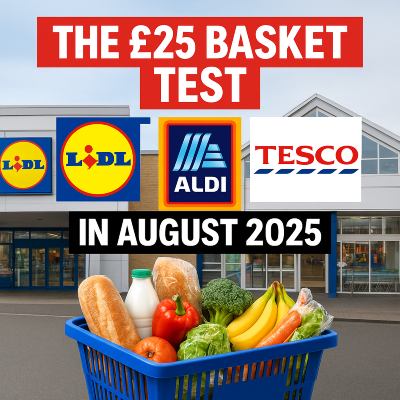LONDON, August 20, 2025 — Lidl has overtaken Aldi as the UK’s cheapest supermarket, according to Which?’s July price comparison. But the small-shop reality suggests the real contest for value is happening not on 76-item mega baskets, but in the £25 top-up that dominates weekly household spending.
Lidl edges Aldi in July basket
Which?’s monthly survey priced a 76-item trolley across eight supermarkets. Lidl came in cheapest at £128.40 without Lidl Plus — and £128.00 with the app — nudging ahead of Aldi’s £129.25. The difference was just 85p.
Asda followed at £139.53, while Tesco, with Clubcard Prices, totalled £141.92. Waitrose was highest at £170.91, a gap of more than 30% compared with Lidl.
It was the first time in nearly two years that Aldi lost the cheapest crown, underscoring how fine the margins have become in the discounter battle.
The £25 basket reality
The Which? headline grabs attention. But most shoppers aren’t filling 76-item trolleys. According to Kantar, households are splitting their spend across multiple retailers, with average families visiting four supermarkets each month.
That reality means the £25 basket — a typical top-up of milk, bread, eggs, fruit, pasta and coffee — matters more than the mega-shop.
Here, discounters keep it simple: the shelf price is the final price, no loyalty app required. By contrast, Tesco and Asda can undercut discounters — but only if the right items fall under Clubcard Prices or Asda Rewards.
Loyalty roulette
Consumer groups warn that loyalty mechanics can distort the picture. “Simply choosing one supermarket over another could save you 25 per cent — but only if you use the right loyalty offers,” said Which? retail editor Reena Sewraz in the July release.
That creates what analysts dub “loyalty roulette”: a branded pasta sauce, teabags or ketchup might be 50p–75p cheaper with a card. Miss the promotion, and the basket flips back in favour of Aldi or Lidl.
The appeal of discounters, therefore, is as much about mental energy as price: no apps, no calculations, no fear of missing out.
Inflation still bites
The context is stubborn inflation. Kantar data shows grocery price inflation running at 5.2% in the four weeks to July 13, down only slightly from earlier this year. The ONS recorded headline CPI inflation at 3.6% in June.
That means even tiny savings at the till — 20p on milk, 30p on bread — resonate strongly with households. The £25 basket amplifies those differences: the value gap between discounters and the big four may be only pennies, but for families repeating the trip every week, the arithmetic compounds.
Trade implications
For retailers, the optics matter as much as the totals. Lidl’s July win drew national headlines, reinforcing its value reputation. Tesco and Asda are fighting back by doubling down on loyalty mechanics: Tesco now pushes more than 8,000 Clubcard Prices across stores, while Asda is expanding its Rewards app with cashpot-style incentives.
“The perception of being cheapest can be more powerful than the actual difference,” one retail analyst told GSN. “The danger for the big four is that discounters win trust through consistency, while loyalty schemes can feel like hoops to jump through.”
What to watch in August
- Clubcard cycles: If Tesco pushes discounts on branded staples again, it could undercut discounters for mixed baskets.
- Discounters’ stability: Lidl and Aldi rarely change base pricing, which builds trust.
- Inflation pressure: At ~5% grocery inflation, small swings in staples remain politically and socially sensitive.
Bottom line
The £25 basket test is not a formal index. But as a lens on how shoppers really experience price competition, it is revealing. Lidl’s win over Aldi in July shows how tight the discounter race has become. Yet for consumers, the more important rule of thumb remains simple:
Pick your lane per trip.
- For basics, discounters win on clarity and consistency.
- For brand-heavy baskets, Tesco and Asda can be cheaper — but only if you play the loyalty game.
That is the real price reality in August 2025.



